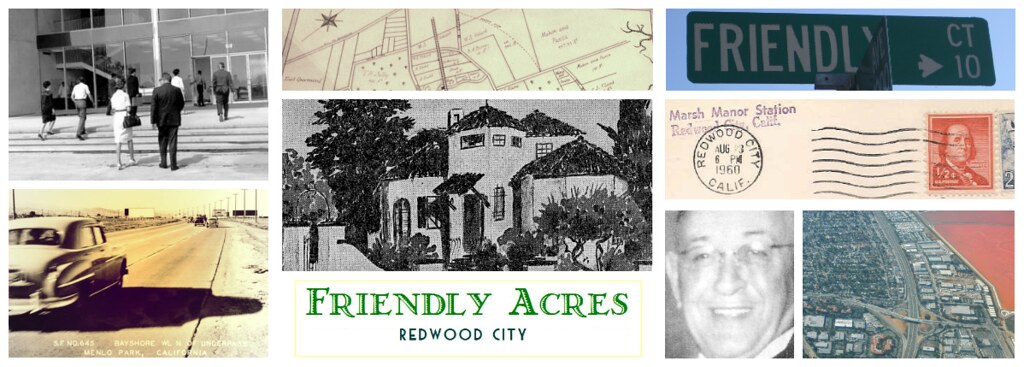Flying Ace crashes in Friendly Acres
World War II came to a sudden and vivid reality for residents of Friendly Acres in Redwood City late one Monday afternoon in 1943 when a fighter plane made a spectacular crash landing into the neighborhood.
It was April 12th and a young 25 year old army flier from Callendar, Iowa, 2nd Lt. Lowell K. Brueland, had been on a practice flight on a single-seat fighter plane over the bay. Heading west over the San Mateo Bridge from Hayward AFB, his plane suffered engine trouble and he was forced to quickly find somewhere where he could make an emergency landing. Running out of possibilities he stayed close to the shoreline of the bay aiming for some sort of belly landing, and managed to get himself to Sanders' field (aka Sweeny Ranch airport) just south of Redwood City, which had in earlier days been a private airport. (Today the Ampex land just north of 2nd Ave. and south of Chestnut in Redwood City).
April 13, 1943 San Mateo Times Cutting "a half-mile swath through a field and across three streets, finally coming to rest in a vacant lot, next door to a home on Page street near Fourth avenue."
"When the plane touched the ground its momentum carried it to the south boundary of the field at Second avenue, where it smashed through a barbed wire fence into the residential area.
"Carrying 30 feet of fence wire and two posts, the plane dug a track across Page street near Third avenue - missing two telephone poles by a few feet, and crossed Fourth avenue into the vacant lot, where the pilot managed to wheel it around. Had it gone another 100 feet it would have crashed into the side of a house on Page south of Fourth avenue.
"It missed the backyard fence of a home on Fourth avenue by inches, and an automobile parked at the intersection by feet.
"Lieutenant Brueland climbed out uninjured.
"Householders called Sheriff McGrath's office, and Deputies John O'Brien, Paul Jensen, and William Schade formed a guard around the plane until the arrival of soldiers and an army wrecking crew."
For airplane aficionados wondering what kind of plane it was - it was most likely a P-38 or P-39 airacobra - not a test P 51 mustang, since the Hayward Army Airodrome, where Lt. Brueland and the 355th Fighter Squadron (354th FG) were stationed, housed cobras. The P-39 was the first plane of its kind to have the engine installed in the center fuselage, behind the pilot, but it was handicapped by the absence of an efficient turbo-supercharger which limited it to low-altitude work. This is of note, because the kind of combat flying that Brueland was eventually assigned to was low-level flying - what some may call "cannon fodder".
The 354th were at the time a relatively new group, only recently formed in November 1942, based out of Hamilton Field, just north of San Francisco. Their group leader had anticipated his teams would take on aerial defense of the Pacific Northwest as well as tactical flying over Japan, given the Pearl Harbor surprise of eleven months earlier. However the group instead found themselves deployed to Europe around November of 1943 to later take part in some of the most famous flying battles over French and German skies leading up to D-Day.
In January of 1943 the 354th were sent to Nevada for gunnery training and by March, two months later, were back in California. The 355th were based out of the Hayward airodrome, where they specialized in low level flying, and were separate from the main 354th group and other squadrons who were HQ'd at Hamilton Air Field, north of San Francisco . By May, the group had been relocated to Portland, Oregon, for final training and to be joined by many new pilots, but they were all still unsure about whether they were to deal with the Japanese or European theater. In October they found out: Taking the train cross-country to New Jersey, the group boarded the "Athlone Castle" liner and were shipped to Liverpool. By Christmas, the 354th found themselves stationed at Boxted Airfield in Eastern England and with great excitement realized they would be the first to fly the P51 Mustangs.
 |
| Lt. Lowell K. Brueland |
Brueland's name and actions seem destined for posterity. There is even archival footage available online of one his combat missions showing him shooting down 2 ME 109 fighters:"On June 5, 1944, the paratroopers loaded into gliders and C-47 transport planes. Mr. Brueland was one of 72 P-51 fighter pilots who escorted them into France. The fighters, whose pilots became honorary members of the "Band of Brothers," were in three, 24-plane squadrons, spaced at 9,000, 25,000 and 35,000 feet, he said. Mr. Brueland and his squadron, flying at the 9,000-foot level, were assigned to suppress ground fire. The other squadrons were poised for air combat. The paratroopers were assigned missions behind German lines to protect the invasion that began at dawn on June 6, 1944." (Source: Independent Mail, Anderson, SC. Oct 13, 2006)
For his valor in combat Brueland was awarded numerous medals. Notably the Distinguished Service Cross and the Silver Star. Click here to find out more about his citations. He managed to stack 12.5 recorded kills (excluding 3 probables and 6 damaged - although sources differ on the stats). And ranks as the 3rd highest ace in the group in terms of victory kills.
Distinguished Service Cross: On 28 July 1944, during a fighter sweep in the St. Lo area, Captain Brueland fearlessly led his eight-ship formation in an expertly executed attack on over sixty fighter and fighter bomber airplanes which were headed for the Allied front lines. In the ensuing combat, Captain Brueland destroyed three enemy fighters and damaged a fourth. Through his expert leadership, superior aerial proficiency, tactical technique, and extraordinary heroism against tremendous odds, the enemy fighters were completely dispersed and driven off. In addition the fighter bombers were forced to jettison their bombs, thus eliminating the threat to the Allied front.
Silver Star: On 13 May 1944, while leading a squadron of P-51 type aircraft in a long range escort mission, Captain Brueland demonstrated extraordinary courage and fearless tactical skill in leading an attack upon more than twenty-five enemy aircraft. Displaying great determination and coolness in the face of unequal odds he pressed home his attacks and accounted for one enemy aircraft destroyed while dispersing the remainder.
There were many more aerial dogfights and missions that Brueland and his companions served in. A comprehensive tribute documentary "Heroes of the 354th" by Jon Teboe may also be viewed at www.angelfromhellthemovie.com.
 |
| Add captionLt. Col. Brueland, age 90, at Hollister Airport beside his P-51 "Grim Reaper" Mustang in 2008, at a Reunion for the 354th FG. Image by C. Fowles. Source: https://bit.ly/2TIUHsc |
Promoted to Major in 1945, Brueland decided to stay on with the Airforce and signed up for a permanent career in 1947. His final promotion was to Lt. Colonel in 1955 and he eventually retired in 1968.
To Lt. Col. Brueland and all the heroes of the 354th Fighting Group and all those who served to protect our freedom and this little corner of Redwood City that is Friendly Acres, we remember you, we salute you and we thank you.
Post Script: July 11 2012.
After noticing a rash of visits this week to this blog I discovered that the cause of such traffic had been prompted by the sad news of Colonel Brueland's death. Throughout his astounding flying career and through all of his missions he had the most amazing luck, landing every single plane he ever flew. Some might say he wore the wings of angels on his back. He joined their ranks on Monday July 2nd having passed away at age 94, at his residence at 420 La-Z Acres road, Westminster, South Carolina.
A funeral service is expected to be held at Arlington National Cemetery, with full military honors. Online condolences may be made at the Acree-Davis Funeral Home web page: http://www.acree-davisfh.com/obituaries.htm
Lt. Col Lowell K. Brueland.
March 11, 1918 - July 2, 2012.
References/Sources:Rest in Peace.
- Redwood Tribune Desk, San Mateo Times, April 13 1943.
- Biography of Bob Stephens: http://www.baseballinwartime.com/player_biographies/stephens_robert.htm
- Biography of Lowell Kermit Brueland: http://www.veterantributes.org/TributeDetail.asp?ID=1538
- The 354th Pioneer Mustang Fighter Group: http://www.354thpmfg.com/
- Bell P-39 Airacobra: http://en.wikipedia.org/wiki/P-39
- The North American P51 Mustang: http://en.wikipedia.org/wiki/P-51_Mustang
- Lowell Kermit Brueland - Citations and Medals: http://militarytimes.com/citations-medals-awards/recipient.php?recipientid=23023
- WWII Fighter Ace ready for Paratrooper reunion.: http://www.independentmail.com/news/2006/oct/13/wwii-fighter-ace-ready-for-paratrooper-reunion/
- "Heroes of the 354th" by John Teboe: http://www.angelfromhellthemovie.com
- "354th Fighter Group" by William Hess, pub. March 22, 2002, Osprey Publishing ISBN 1841 763152









